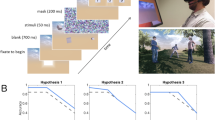Abstract
Binocular depth inversion represents an illusion of visual perception. Such an inversion does not occur in all cases, especially when objects with a higher degree of familiarity (e.g. photographs of faces) are displayed. Cognitive factors are assumed to override the binocular disparity cues of stereopsis. We tested the hypothesis that during psychotic and similar states the human CNS is unable to correct the implausible perceptual hypothesis. Measurements of binocular depth inversion in perception of 3D objects were performed in schizophrenic patients (n=13), in patients with alcohol withdrawal (n=10), in sleep-deprived medical staff (n=10) and in healthy volunteers (n=41). The binocular depth inversion scores were highly elevated in the patient group and in the sleep-deprivated medical staff in comparison with healthy volunteers. The data demonstrate that impairment of binocular depth inversion reflects a common final pathway, characterized by an impairment of adaptive systems regulating perception.
Similar content being viewed by others
References
Broadbent D (1958) Perception and communication, Pergamon Press, New York
Carlsson A (1988) Speculations on the control of mental and motor functions by dopamine-modulated cortico-striato-thalamo-cortical feedback loops. M Sinai J Med
Chapman LJ, Chapman JP (1973) Disordered thought in schizophrenia. Meredith, New York
Emrich HM (1988) Zur Entwicklung einer Systemtheorie produktiver Psychosen. Nervenarzt 59:456–464
Emrich HM (1989) A three-component-system-hypothesis of psychosis. Impairment of binocular depth inversion as an indicator of functional dysequilibrium. Br J Psychiatry 155 (Suppl 5):37–39
Emrich HM, Weber MM, Wendl A, Zihl J, Meyer L von, Hanisch W (1991) Reduced binocular depth inversion as an indicator of cannabis-induced censorship impairment. Pharmacol Biochem Behav 40:689
Frith CD, Done DJ (1989) Experiences of alien control in schizophrenia reflect a disorder in central monitoring of action. Psychol Med 19:356–363
Frith CD, Done DJ (1988) Towards a neuropsychology of schizophrenia. Br J Psychiatry 153:437–443
Gray JA, Rawlins JNP (1986) Comparator and buffer memory: an attempt to integrate two models of hippocampal functions. In: Isaacson RL, Pribram KH (eds) The hippocampus, vol 4. Plenum Press, New York, pp 159–201
Heinemann LG (1966) Der mehrtägige Schlafentzug in der experimentallen Psychoseforschung: Psychopathologie und EEG. Arch Psychiatr Z. Ges Neurologie 208:177–197
Huxley A (1954) The doors of perception. Chatto and Windus, London
Malenka RC, Angel RW, Hampton B, Berger PA (1982) Impaired central error-correcting behavior in schizophrenia. Arch Gen Psychiatry 39:101–107
McGie A, Chapman J (1961) Disorders of attention and perception in early schizophrenia. Br J Med Psychol 34:103–117
Mumford D (1992) On the computational architecture of the neocortex. Biol Cybern 66:241–251
Olton DS (1989) Mnemonic functions of the hippocampus: single unit analyses in rats. In: Chan-Palay V, Köhler C (eds) The hippocampus: new vistas. Liss, New York, pp 411–424
Sullivan JT, Sykora K, Schneidermann J, Naranjo CA, Sellers EM (1989) Assessment of alcohol withdrawal: the revised clinical institute withdrawal assessment for alcohol scale. Br J Addiction 84:1353–1357
Van den Enden A, Spekreijse H (1989) Binocular depth reversals despite familiarity cues. Science 244:959–961
Wagemans J, Kolinsky R (1994) Perceptual organisation and object recognition—POOR is the acronym, rich the notion. Perception 23(4):371–382
Watzlawick P (1985) Wirklichkeitsanpassung oder die angepasste “Wirklichkeit”? In: Einführung in den Kontruktivismus (Schriften der Carl-Friedrich-von-Siemens-Stifung, Bd. 10) Oldenbourg, München
West L, Janszen HH, Lester B, Comelisoon FS (1962) The psychosis of sleep deprivation. Ann N Y Acad Sci 96:66–70
Wheatstone C (1838) Proc R Soc 128:371–394
Wheatstone C (1852) Philos Mag 4:504
Wolf R (1985) Binokulares Sehen, Raumverrechnung und Raumwahrnehmung. Biologie unserer Zeit 15:161–178
Yellott JI (1981) Binocular depth inversion. Sci Am 245:118–125
Author information
Authors and Affiliations
Rights and permissions
About this article
Cite this article
Schmeider, U., Leweke, F.M., Sternemann, U. et al. Visual 3D illusion: A systems-theoretical approach to psychosis. Eur Arch Psychiatry Clin Nuerosci 246, 256–260 (1996). https://doi.org/10.1007/BF02190277
Received:
Issue Date:
DOI: https://doi.org/10.1007/BF02190277




